Book contents
- Decriminalizing Mental Illness
- Decriminalizing Mental Illness
- Copyright page
- Contents
- Contributors
- Part I Introduction/Description of the Problem
- Part II Solutions
- Part III Psychopharmacological Treatment Considerations
- Part IV Nonpsychopharmacological Treatment Considerations
- Chapter 21 Neurocognition and Social Cognition Training as Treatments for Violence and Aggression in People with Severe Mental Illness
- Chapter 22 Examining Violence Among Not Guilty by Reason of Insanity State Hospital Inpatients Across Multiple Time Points: The Roles of Criminogenic Risk Factors and Psychiatric Symptoms
- Chapter 23 Criminogenic Risk and Mental Health: A Complicated Relationship
- Chapter 24 Implementation of a Specialized Treatment Program to Reduce Violence in a Forensic Population
- Chapter 25 From Trauma-Blind to Trauma-Informed: Rethinking Criminalization and the Role of Trauma in Persons with Serious Mental Illness
- Chapter 26 The Indistinguishables: Determining Appropriate Environments for Justice-Involved Individuals
- Chapter 27 Breaking Down Long-Term Chronic Aggression Within a Forensic Hospital System
- Part V Criminal Justice and Social Considerations
- Index
- References
Chapter 27 - Breaking Down Long-Term Chronic Aggression Within a Forensic Hospital System
from Part IV - Nonpsychopharmacological Treatment Considerations
Published online by Cambridge University Press: 19 October 2021
- Decriminalizing Mental Illness
- Decriminalizing Mental Illness
- Copyright page
- Contents
- Contributors
- Part I Introduction/Description of the Problem
- Part II Solutions
- Part III Psychopharmacological Treatment Considerations
- Part IV Nonpsychopharmacological Treatment Considerations
- Chapter 21 Neurocognition and Social Cognition Training as Treatments for Violence and Aggression in People with Severe Mental Illness
- Chapter 22 Examining Violence Among Not Guilty by Reason of Insanity State Hospital Inpatients Across Multiple Time Points: The Roles of Criminogenic Risk Factors and Psychiatric Symptoms
- Chapter 23 Criminogenic Risk and Mental Health: A Complicated Relationship
- Chapter 24 Implementation of a Specialized Treatment Program to Reduce Violence in a Forensic Population
- Chapter 25 From Trauma-Blind to Trauma-Informed: Rethinking Criminalization and the Role of Trauma in Persons with Serious Mental Illness
- Chapter 26 The Indistinguishables: Determining Appropriate Environments for Justice-Involved Individuals
- Chapter 27 Breaking Down Long-Term Chronic Aggression Within a Forensic Hospital System
- Part V Criminal Justice and Social Considerations
- Index
- References
Summary
Inpatient aggression within psychiatric facilities continues to demand attention. Aggressive acts often cause physical or psychological injury that impact the lives of the patients or staff victims of these incidents. However, it should be noted that the vast majority of psychiatric patients are not aggressive while hospitalized. Studies on inpatient aggression showed approximately 25%–35% of inpatients committed acts of aggression. For those inpatients who are aggressive, there is a substantial literature that that describes a small subset of “chronically aggressive” patients, who are responsible for the majority of inpatient aggression.
- Type
- Chapter
- Information
- Decriminalizing Mental Illness , pp. 272 - 280Publisher: Cambridge University PressPrint publication year: 2021

